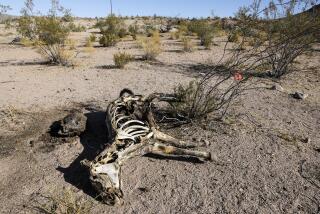Colorado Yields Bones Galore to Scientists
- Share via
NEW RAYMER, Colo. — Not much has changed on the Pawnee National Grassland in 35 million years, scientists say.
There was more precipitation then, about 25 inches annually compared with 15 today, and there were more trees. The rolling hills would have been much the same, with taller grass and a warmer climate.
Instead of the treeless prairie of today, there were clusters of trees 35 million years ago--walnut, maple and cottonwood. But the real change in this land is with the animals.
Today, there are cattle in all directions, antelope grazing in the distance and hawks floating overhead, watching for prairie dogs below.
But 35 million years ago, giant pigs were here, about the size of cows, and rhinoceros-like beasts who stood 8 feet at the shoulder. There were dog-sized horses and camels and small deer, alligators and huge turtles.
Scientists and volunteers from the Denver Museum of Nature & Science recently worked in the broken clay, sand and volcanic ash 10 miles north of New Raymer in northeastern Colorado, where they found bones of prehistoric animals at a place aptly named “Bones Galore.”
The site was discovered several years ago, and the crew returns to spend two weeks there each summer, unearthing evidence of the rhinos, pigs, horses, camels and saber-toothed cats.
“We’ve found bones of at least four titanotheres,” said museum curator Russ Graham, who heads the Bones Galore project. “They were the large rhino-like animals that weighed up to 6,000 pounds. It was the largest land animal of its time, and the ones we found were the last to die in this area.”
Graham said the team found one complete skeleton of a titanothere, plus bones and teeth from the other animals. The arrangement of the bones and the way the land formed in the area indicates a watering hole, and many animals died there.
The crew working with Graham included Bruce Schumacher, a paleontologist for the U.S. Forest Service, and Emmett Evanoff, a geologist from Boulder.
Standing at the dig site and looking across the prairie toward the Pawnee Buttes, Evanoff said, “A huge sea covered this area 65 million years ago, and after it disappeared, the Rocky Mountains rose, and huge amounts of volcanic ash from Nevada, Utah and central Colorado hit this area.”
Although the land where the bones were found is about 35 million years old, the rocks on the top of the Pawnee Buttes, about 10 miles northwest of the site, are only 18 million years old. “This area [where the bones were found] was formed long before the land around the Buttes eroded away,” Evanoff said.
The exact location of the dig, on federal land, is kept secret to prevent souvenir hunters from carrying away prehistoric finds.
About 10 volunteers, who have become amateur paleontologists on their own, worked the site.
The Denver museum offers volunteers the chance to work in the labs and on the digs and other projects.
“Denver has the greatest museum for volunteer digs,” said Sue Brown, a satellite systems engineer from Denver. “We’re allowed to work at the dig, bring back what we’ve found, research it and write a paper about it if we want.”
Brown recently worked at the base of one of the dig holes, where she uncovered parts of the skull of a brontothere, another type of rhinoceros.
Dan Smith, who lives in England near London, joined the volunteers this summer to learn more about Colorado prehistoric history. “I heard about the dig on the Internet,” said Smith, who uncovered a huge tooth of a prehistoric pig at the site. “I wanted to come and find out what an American dig was like.”
The team used small, pointed awls, screwdrivers, toothbrushes, dental tools and even large shovels and pickaxes to dig for their prehistoric treasure.
The top layers of soil were removed with a backhoe, then volunteers used smaller tools as they dug deeper. At the main level, where the bones were found, they used small dental tools and brushes to remove the earth around the fossils.
“It’s like opening a gift,” said Brown. “Only until you get the dirt completely away, you don’t know if it’s a gag gift or the real thing.”
More to Read
Sign up for Essential California
The most important California stories and recommendations in your inbox every morning.
You may occasionally receive promotional content from the Los Angeles Times.













